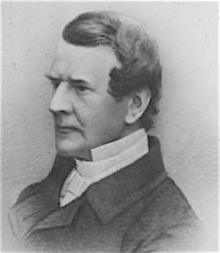
John Oldrid Scott was born in London, England on 17 July 1841. His father was the architect George Gilbert Scott (1811-1878) with whom he was articled in 1860. After completing his articles, he remained with him as his as his assistant.
He commenced practice as an independent architect in London in 1864 and worked primarily as an ecclesiastical architect.
Following his father's sudden death in 1878, he continued his practice, completing some of his unfinished projects, and that year was elected a Fellow of the Royal Institute of British Architects (FRIBA).
Later in his career he formed partnerships with Charles Thomas Miles (1852-1930) and with his son, Charles Marriott Oldrid Scott (1880-1952).
Scott was a frequent exhibitor at the Royal Academy in London from 1869 to 1904.
His address was given as 31 Spring Gardens, London in 1869 and 1893; 35 Spring Gardens, London in 1897; and 2 Dean Yard, Westminster, London in 1903 and 1904. He later lived in Peasmarch, Sussex. He died at 9 Marine-mansions Bexhill Sussex on 30 May 1913. His address at the time of his death was Ridgeway House, Oxted, Surrey.
A biographical file on John Oldrid Scott is available at the Enquiry Desk, Royal Institute of British Architects Library, London
Greek Orthodox Cathedral of Aghia Sophia, Moscow Road, London (1873-82); restoration of St Peter's Church, Clayworth, Nottinghamshire (1874–75); St. Mary's Church, Slough, Buckinghamshire (1875-1913); St. Mary's Church, Chailey, Sussex (1876); St. Paul's Church, New Cross, Oldham Road, Manchester (1876-78); restoration of St. Thomas' Church, Osbaldwick, York (1877-78); St Mary's Church, Slough (1878); additions to St Mary's Church, Hayes, Kent (1878–79); Boathouse, University College Boathouse, Oxford (1880–81); St Mary's Cathedral Song School in Edinburgh (1881); St Bartholomew's Church, Hints, Staffordshire: (1882–83); restoration of St Mary the Virgin's Church, Adderbury, Oxfordshire (1886); Cathedral Church of the Resurrection, Lahore, India (1887); restoration of Mary the Virgin's Church, Thame, Oxfordshire (1889–97); restoration of St Mary and St Peter’s Church, Harlaxton, Lincolnshire (1890-91); the Chapel, Bradfield College, Berkshire (1890-91); Rectory, St Denys' Church, Northmoor, Oxfordshire (1891); restoration of St John the Baptist's Church, Kinlet, Shropshire (1892); St John the Evangelist's Church, Boscombe, Dorset (with Charles Thomas Miles, 1893–95); St Philip's Church, Hove, Sussex (1894–95); restoration of St Alkmund's Church, Duffield, Derbyshire (1896–97); St Mark's Church, Harrogate, Yorkshire (1898); restoration of St Nicholas' Church, Piddington, Oxfordshire (1898); restoration of St Mary the Virgin's Church, Denby, Derbyshire (1901-03); restoration of St Giles' Church, Wendlebury, Oxfordshire (1902); St John the Evangelist's Church, Palmers Green, Middlesex (1903–08); additions to the Engineering Building, University of Glasgow (1907) St George the Martyr's Sunday School and Church Institute Building, New Wolverton, Buckinghamshire (1907-08); additions to St Michael and St George Cathedral, Grahamstown, South Africa (1912); and St James's Church, Milton, Hampshire (1911–13).
Church Art. [Catalogue of an exhibition at the Victoria & Albert Museum, London, 1971-72]. London: Her Majesty’s Stationery Office, 1971 pp. 138-140
Directory of British Architects 1834-1914. Compiled by Antonia Brodie, et al. Volume 2: L-Z. London; New York: British Architectural Library, Royal Institute of British Architects/Continuum, 2001
‘Obituary’. The Builder vol. 104, 6 June 1913 pp. 643, 650-651
‘Obituary’. RIBA Journal, 3rd series, vol. 20, 1912-13 pp. 614, 648
‘Obituary’. The Times 2 June 1913 p. 11